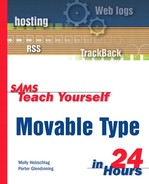ecto
| Web Site: | http://www.kung-foo.tv/ecto/ |
| Platform(s): | Mac OS X (Windows version planned) |
| License: | Shareware—$17.95 (free trial) |
This follow-up to the well-respected Kung-Log by Adriaan Tijsseling is, simply put, one of the best desktop clients out there. The only sad thing is that it's only currently available to Mac OS X 10.2 and 10.3 users. However, the ecto site says that a Windows version is in the works.
Installing and Configuring ecto
ecto is available for download as a compressed disk image. Download the file, decompress it, and mount the disk image. In all likelihood, this will all happen automatically when the file is downloaded. After accepting the license agreement, move the application files to wherever you want them on your computer, such as the Applications folder.
The first time you run ecto, the Account Assistant will walk you through the process of creating your first account.
1. | Enter the URL of your weblog's home page and click Next. |
2. | The Account Assistant will attempt to discover the type of weblog and your XML-RPC URL as shown in Figure 21.9. Check that it got them right, and correct them if necessary before clicking Next. Figure 21.9. ecto has detected that I'm using Movable Type!
|
3. | Enter your Movable Type username and password in the Username and Password fields, and click Next. |
4. | On the next screen, enter a name for this account. If you use ecto to post to multiple servers, you will need to create an account for each of them, and this name will be how the account is labeled in ecto's interface. |
5. | Set the default posting options on this next screen shown in Figure 21.10. Check the Comments box to allow comments by default, the Trackback box to allow TrackBack pings, and the Linebreaks box to have Movable Type convert line breaks into HTML markup. Click Next when you've got these set as you want them. Figure 21.10. Set the default posting options for the account being created.
|
6. | The next screen allows you to set the Blogging Mode that ecto will operate in. For now, leave this set to Beginner. You will be able to change this later by selecting the Set Usage Mode submenu of the main ecto menu. |
7. | Click Finish on the last screen to create the account. |
You should now be looking at a screen similar to the one in Figure 21.11, ecto's main editing window.
Figure 21.11. ecto's simple editing window hides the extra options until you need them.

Using ecto
The first thing you should do when creating a post is to verify that the currently selected weblog is the one you want to work with. If you are only using ecto with a single server that has only a single weblog, you can ignore this since ecto will default to that one weblog. On the other hand, if you're using it with multiple weblogs, you'll want to pay attention to this.
The title bar of the main window lists the account name of the currently active account as well as the title of the currently active weblog within that account. Click the Weblogs button in the toolbar if you want to change to a different weblog.
Now that you've got the proper weblog selected, let's go ahead and post an entry.
1. | Enter a title in the text field just below the toolbar. |
2. | Enter the body of your post in the large textarea below that. |
3. | Click the Continuation/Summary button if you want to enter an excerpt or extended body for your entry. The top field on the Continuation/Summary screen is for the extended entry, and the bottom field is for the excerpt. |
4. | Click the Advanced tab (shown in Figure 21.12) to enter keywords or URLs to ping or to change the entry's creation date and time. Figure 21.12. Adding keywords or manipulating the entry's timestamp is just a quick trip to the Advanced screen. |
5. | If you'd like to change any of the default posting options or assign the entry to one or more categories, click the Settings button in the toolbar to open the Settings drawer in Figure 21.13. |
6. | Once everything is set the way you want it, click the Post button in the toolbar to send the entry to your server. |
Editing entries is just as easy. For that, you'll need to open the Entries and Drafts window.
1. | Click the List button in the main window's toolbar or press Command+L on the keyboard; you'll see a menu like the one in Figure 21.14. |
2. | Click the Refresh button in the bottom-left corner to fetch the latest list of entries for the current weblog from your server. |
3. | Double-click the entry you want to edit to open it. |
4. | |
5. | A dialog will pop up asking you to confirm that you are editing an existing entry and not creating a new one. Click the Send Edit button. |
You should then see a status message confirming that the server received your edits properly.
The Entries and Drafts window is also how you can delete entries from your weblog.
1. | |
2. | In the confirmation dialog, shown in Figure 21.15, check the Delete From Server box. Leaving this box unchecked will cause ecto to delete its local cache of the entry, but leave it on the server. Figure 21.15. ecto confirms that you wanted to delete the entry and offers you the choice of only deleting it locally or from the server as well.
|
3. | Click the Delete button. |
The entries list in the Entries and Drafts window should now refresh to show that the entry has been deleted.





